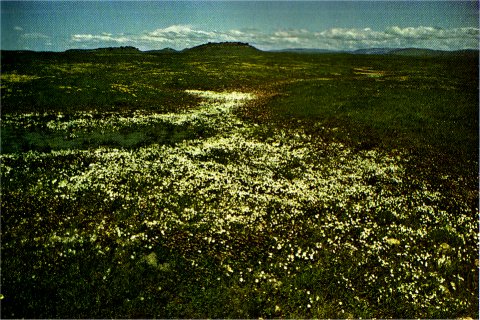
[click to enlarge]
Meadow Foam in Sierra Foothills,
Limnanthes douglasii var. rosea
| Online Library: | Title | Author | California | Geology | History | Indians | Muir | Mountaineering | Nature | Management |
Yosemite > Library > Wildflower Trails > Sierra Foothills and Approaches to Yosemite >
Next: Yosemite Valley • Contents • Previous: Preface
Visitors to Yosemite National Park who approach from the west—and this a large majority—travel through many miles of foothill country before arriving at their destination. Whether they use State Highway #41 from Fresno, #140 out of Merced or #120 via Oakdale and Groveland (the Big Oak Flat Road), such an approach will be enhanced by a pleasing variety of wildflowers in March, April and May.
As the first groundswells of the Sierra lift above the flatlands of the San Joaquin Valley, the wildflowers begin to appear. One of the showiest of these low-elevation plants is Tidy Tips (Layia fremontii), a very handsome member of the sunflower family. The foot-high, rather hairy, branching stems support flowers about two inches across. Orange-gold petals terminate in prominent white tips, giving the blossoms a distinctively elegant appearance. Tidy tips prefer the gently rolling grasslands of the lowest foothills, and are at their best in March and April. In March too, the open, sunny flats of these low foothills are blanketed by a tiny composite called Goldfields (Baeria chrysostoma). Only a few inches high, its uncounted numbers of individual yellow blooms make an impressive mass of color across the landscape.
Another brilliant tonal effect is created in this same area by a small white flower called Meadow Foam (Limnanthes douglasii var. rosea). It grows in great profusion around the borders of pools and seeps in the folds of the lowest hills, creating the illusion of frothy, white foam or isolated snow drifts, startling in the wide expanse of green grass. The individual flowers are attractively lined with pink veins across the petals and are on stems 4 to 10 inches high, but it is the total mass which produces its remembered beauty.
A type of flower commonly seen in this region is the genus known as brodiaea, of the lily family. In good wildflower years, at least five different species will be found

[click to enlarge] Meadow Foam in Sierra Foothills, Limnanthes douglasii var. rosea |
Another memorable group of plants, also in the lily family, is the genus calochortus, familiarly called Mariposa lily. Some of the more common representatives of this genus develop large, open, bowl-shaped blossoms, in colors of white, yellow or lavender-pink, with vividly contrasting designs at the base of each petal. Growing on long, slender stems also, they are to be found from foothills to high mountains; we will find the white form of the Mariposa lily again in Yosemite Valley and later along the High Sierra Loop Trail. Perhaps the most exquisite of the calochortus (meaning, literally, “beautiful grass”—and the leaves are grass-like) is the Fairy Lantern or Globe Lily (Calochortus albus). Its lantern-like blossoms, creamy white, hang pendent from the two-foot-high flower stalks, with a graceful quality of great appeal. Instantly, the similarity to Japanese lanterns is brought to mind. Look for these unusually beautiful flowers in shady, rather rocky locations and often, conveniently, in road cuts. They bloom in April and May.
One of the early bloomers, and one of the more colorful, is the charming little annual commonly called Baby-Blue-Eyes (Nemophila menziesii). It can be found between 2,000 and 4,000 feet in grassy or brushy places, often forming pools of intense sky-blue where the blossoms crowd together. Sometimes these flowers are distributed broadly across grassy slopes, like fine stardust. Their 5-petaled flower cups, deep blue with white centers, are usually about an inch across and are borne on slightly hairy stems with compound leaves divided into many toothed segments. The deeply saturated blue blossom is easily seen as one drives the foothill roads, even though the flower stems are but 4 to 10 inches high.
In the same general altitude (1,300 to 5,000 feet) there often will be found great numbers of another striking blossom. Since it usually blooms in May, when much of the foothill area is drying at the close of the rainy season, it is known by the common but appropriate name of Farewell-to-Spring (Clarkia purpurea ssp. quadrivulnera). The predominant color is lavender, often verging on a deep pink, with a spot of deeper tone near the base of each of the four petals. It prefers brushy or wooded areas and competes with the tall grass by growing on slender stems 1 to 3 feet long. The species illustrated is very similar in color and form, but may be distinguished from Clarkia purpurea ssp. quadrivulnera by the pendulous buds. It is identified as Clarkia dudleyana.
One of the most common and typical of California wildflowers is the lupine, a member of the pea family. It is found from seacoast to mountain peak and occurs in many widely varying species. Most lupine blossoms are in shades of blue, red-violet or purple, although some lupines are yellow, others white and one (Harlequin Lupine —Lupinus stiversii) has the unusual color combination of yellow and pink in a single blossom. As one drives through the foothills to Yosemite in April, one of the most impressive flower spectacles between 2,000 and 4,000 feet is the Bush Lupine (Lupinus albifrons), forming great rounded masses of magenta-purple, the long blooming spikes often tipped with silvery gray where the individual blossoms are still in bud. The shrubs may reach heights of 4 to 5 feet. Their leaves are in the spreading palmate form so typical of lupine, silvery-hairy in texture, light green in color. They seem to enjoy the roadsides and will frequent rocky cuts; they are indeed worthy forerunners of the scenic grandeur and floral beauty which lie ahead.
A drive up the Merced River Canyon along State Highway #140 from mid-March to mid-April will be rewarded by one of the most colorful flowering displays of the year. This is the time when the Western Redbud (Cercis occidentalis) comes into bloom, and its small, boat-shaped, magenta-colored blossoms produce great mounds of brilliance on the tree-sized shrubs growing along the river. As the leaves do not appear until the flowers have begun to fade, there is nothing to compete with the tremendous surge of color. Later, the rounded, bright green leaves appear, and the shrubs are attractive in that aspect as well. Throughout the summer, the long, rusty-red seed pods hang on the branches, themselves giving almost a blossoming effect.
Another shrub or small tree frequently seen along the Merced Canyon puts out its long, slender leaves in startling green of a deeply saturated quality as the redbud blossoms reach their peak of magenta color. This is the California Buckeye (Aesculus californica), sometimes referred to as “horse chestnut” because of the spectacular brown fruits or nuts which form in late summer. The blending of the green tone of these leaves with the magenta of the redbud is a truly satisfying experience in color imagery. Later in May or early June, long spikes of creamy white blossoms appear in quantity across the rounded profiles of these small shrub-like trees. The spikes are 4 to 6 inches in length, numerous on each tree, and are spectacularly apparent as one drives along the Merced Canyon on Highway #140. They may also be seen from Highway #41 out of Fresno, although not as frequently. The buckeye’s range is between 1,000 and 3,000 feet. Summer visitors will notice these trees, too, for they follow the unusual pattern of shedding their leaves at the onset of the dry season—the only deciduous tree of this region which responds in this manner to the hot, dry foothill summers. With the leaves gone, the large shiny brown seed pods or fruits hang prominently from the branches like decorative ornaments on a Christmas tree.
California Poppies (Eschscholzia californica) frequently make striking springtime displays of orange-gold on the grassy hillsides on any of the approach roads to Yosemite, usually appearing in April. In good wildflower years they are especially dramatic on the steep canyon slopes along the Merced River on Highway #140. It is the California state flower, occurring in grassy, open areas from sea level to nearly 5,000 feet. These brilliant flower cups, up to 2 inches across, consist of 4 petals lifted to the sunlight on stems 9 to 24 inches high, rising from a mass of silvery green leaves divided into numerous fine segments. When poppies grow intermixed with short-stemmed ground lupines, the contrast of orange and blue presents one of the most scintillating effects in the world of wildflowers. Enjoy your poppies in the midday sun, for they close their flower cups in late afternoon and do not reopen until the morning sunshine floods them again with warmth. On overcast days, usually they don’t open at all.
One of California’s most typical shrubs, manzanita, is encountered frequently on any of the three approach roads to Yosemite from the west. There are more than forty species of this shrub in the state, and the one most commonly seen on the foothills of the Sierra is the White-Leaf Manzanita (Arctostaphylos viscida). It is a handsome type, by any standard, and visitors to Yosemite invariably are impressed by its satin-smooth, maroon-colored trunks and branches, thickly covered by small, roundish, gray leaves. These leaves provide the perfect color complement for the clusters of small pink blossoms which hang on the shrub in abundance, like tiny urns with delicate recurved lobes at the throat, from February to April. In midsummer, the blossoms mature as clusters of small, round, russet fruits, bearing a strong resemblance to little apples. The plant derives its name from these fruits, for “manzanita” in Spanish means, literally, “little apple.” At any time of the year the shrub is an attractive landscape addition, its contorted maroon branches often reaching heights of 8 to 12 feet to form small trees. Other species of manzanita are to be found to the 10,000 foot elevation in Yosemite National Park.
A very colorful addition to the roadsides through the foothills and up to 5,000 feet is the little orange-crimson flower called Indian Pink or Catchfly (Silene californica). It prefers brushy or wooded places and is seen near Wawona, on Highway #41, and along Highway #120 west of the Park boundary. Occasionally one finds it in the Merced Canyon, too, along Highway #140. This little beauty appears on stems from 5 to 16 inches high, several arising from a single rootstock. The unusually bright-colored blossom forms a tube which flares out in a flat plane about an inch in diameter, with deeply scalloped, or “pinked,” edges. Look for it in April and May.
Even the casual observer will notice a number of other species not listed above along one of the approach roads to Yosemite in April and early May. Mary Curry Tresidder, writing in her typically sensitive manner about the coming of springtime to the Sierran foothills, calls attention to a further list of seasonal favorites which anyone with eyes to see will be sure to admire:
“At this season, the poppy-colored fiddleneck (Amsinckia intermedia var. eastwoodae), in the fields and along the roadsides approaching the Sierran foothills, is one of the fine displays between Merced or Fresno and Yosemite. The dusty-leaved foothill species of California lilac (Ceanothus cuneatus) has begun to blossom from the Mariposa region upward, and in a few days more it will be showing its rounded creamy bouquets throughout the fields.
“In the moist cuts where water drips from the rocks after a wet winter there are many small treasures such as dwarf shooting stars (Dodecatheon hansenii); sometimes the small-flowered brodiaea known as ‘blue dicks’ or ‘grass nuts’ (Brodiaea pulchella) fringe the rocks in grassy pockets, or a few scarlet paintbrush (Castilleja applegatei) may have ventured out already. An occasional stonecrop (Dudleya cymosa) is already spreading its succulent rosettes of pale green leaves on rocky places that are less fertile, but they have not yet turned to their yellow-ochre coloring nor put up their bright scarlet flowers.
“This is really the period of the year to explore the network of foothill roads, careless of time and speed, in order to observe the embroidery of color on roadsides and flowery fields before the grasses get too high. One finds larkspur (Delphinium hansenii) and golden stars (Brodiaea lutea var. scabra) in the light shade of blue oaks or sparse digger pines, Chinese pagodas (Collinsia heterophylla), white popcorn flowers (Plagiobothrys nothofulvus), cream cups (Platystemon californicus) and tidy tips (Layia fremontii) in the open and along the fences, calico flowers or five-spot (Nemophila maculata), a cousin of the baby-blue-eyes, in patches here and there, and half a dozen assorted brodiaeas and gilias. Blazing star (Mentzelia lindleyi ssp. crocea) shows its dazzling yellow on the hillsides near Oakhurst and on some of the side roads of the Mariposa area or along the lower Big Oak Flat Road. The ‘slippery ellum,’ or flannel-bush (Fremontia californica), is a fairly common golden-flowered shrub blooming in April near Oakhurst on Highway #41.”
Springtime in the foothills of the Sierra—March, April and early May—is a happy season, replete with endless vistas of lawn-green hillslopes, scatter rugs of floral color, bird songs, running streams in gullies and small canyons and long days of sunshine gradually warming toward the intensity of summer. By the end of May, the spring rains have ceased, the high-angled sun shines hotly and the grasses mature to a golden sheen as the flowers fade. Summer has arrived in the foothills; spring has moved on, up the mountain slopes, painting with wildflowers the meadows and canyons of the higher, more spectacular regions.
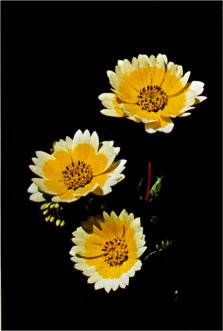
[click to enlarge] Tidy Tips, Layia fremontii |
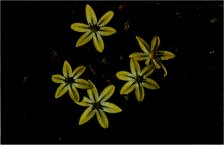
[click to enlarge] Golden Brodiaea, (Brodiaea lutea var. scabra |
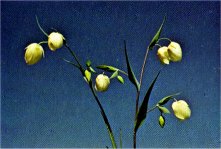
[click to enlarge] Fairy Lantern, Calochortus albus |
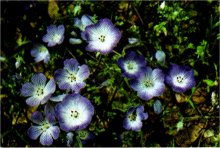
[click to enlarge] Baby-Blue-Eyes, Nemophila menziesii |
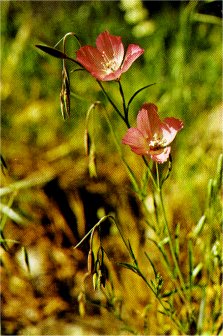
[click to enlarge] Clarkia, Clarkia dudleyana |
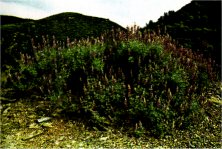
[click to enlarge] Bush Lupine, Lupinus albifrons |
Next: Yosemite Valley • Contents • Previous: Preface
| Online Library: | Title | Author | California | Geology | History | Indians | Muir | Mountaineering | Nature | Management |
http://www.yosemite.ca.us/library/yosemite_wildflower_trails/foothills.html